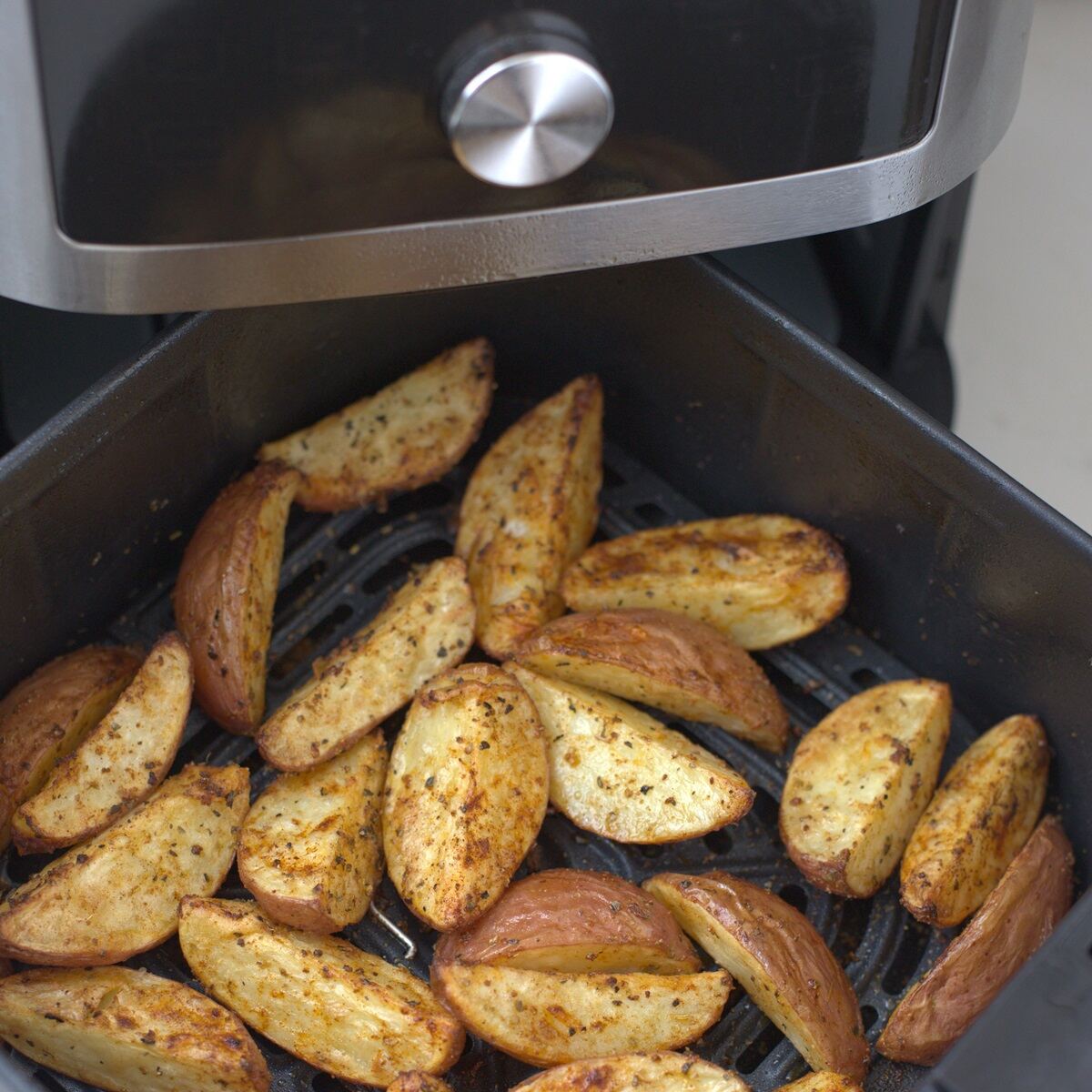Do air fryers produce acrylamide? Yes, air fryers can produce acrylamide, a chemical that forms in some foods when they’re cooked at high temperatures. This article will explore the science behind acrylamide formation in air fryers, potential air frying health risks, and how to minimize its production in your food.

Image Source: instantpoteats.com
Acrylamide and Cooking: The Basics
Acrylamide is a chemical compound that can form in starchy foods during high-temperature cooking methods like frying, roasting, and baking. This process, known as the Maillard reaction, occurs when sugars and an amino acid called asparagine react at temperatures above 248°F (120°C). This reaction is also responsible for the browning and appealing flavors we associate with cooked foods.
Where Does Acrylamide Come From?
Acrylamide isn’t added to food. It’s a natural byproduct of the cooking process. The key ingredients for acrylamide formation are:
- Asparagine: An amino acid naturally found in many vegetables, especially potatoes.
- Sugars: Glucose and fructose, also present in many starchy foods.
- High Heat: Temperatures above 248°F (120°C) are needed for the reaction to occur.
Why Is Acrylamide a Concern?
Studies have shown that acrylamide can be harmful in large doses. Animal studies have linked high levels of acrylamide exposure to an increased risk of cancer. While the effects on humans are still being researched, regulatory agencies like the World Health Organization (WHO) and the Food and Drug Administration (FDA) consider acrylamide a potential human carcinogen and recommend minimizing exposure. Are air fryers carcinogenic because they produce acrylamide? While air fryers can produce acrylamide, this does not directly mean they cause cancer. The risk is related to the level of exposure.
Air Fryer Acrylamide Formation: How It Happens
Air fryers work by circulating hot air around food, similar to a convection oven. This rapid air circulation allows for quick and even cooking, resulting in crispy exteriors. However, the high temperatures used in air frying can also promote acrylamide formation, particularly in starchy foods.
The Role of Temperature
Air fryers often reach temperatures of 350°F (175°C) to 400°F (200°C), which is well within the range for acrylamide formation. The higher the temperature and the longer the cooking time, the more acrylamide is likely to form.
Food Type Matters
Foods that are high in starch and contain asparagine are more prone to acrylamide formation. Potatoes, especially when used for making fries or chips, are a prime example. Other foods that can produce acrylamide include:
- Bread
- Cereals
- Coffee
- Crackers
Air Fryer vs. Other Cooking Methods
It’s important to note that acrylamide isn’t exclusive to air frying. It can form in many cooking methods, including:
- Deep frying: Typically results in higher acrylamide levels compared to air frying.
- Oven baking: Can produce significant acrylamide, especially in baked goods and roasted vegetables.
- Roasting: Similar to baking in terms of acrylamide formation potential.
Acrylamide Levels in Air Fryer vs Oven
An acrylamide potato chips air fryer preparation might have lower acrylamide content compared to traditional deep frying, but how does it compare to oven baking? Studies suggest that air frying and oven baking can produce similar levels of acrylamide, depending on the specific food and cooking conditions. Some research indicates that air frying might produce slightly less acrylamide than oven baking at the same temperature, possibly due to the shorter cooking times. The air fryer acrylamide study results vary depending on the food and cooking temperature.
Air Frying Health Risks: Assessing the Concern
While acrylamide is a concern, it’s crucial to put the air frying health risks into perspective.
Exposure Levels
The amount of acrylamide people are exposed to through their diet is generally much lower than the levels used in animal studies that showed harmful effects. Regulatory agencies have set tolerable daily intake levels for acrylamide, and most people’s dietary intake falls within these guidelines.
Dietary Diversity
A varied and balanced diet is key to minimizing exposure to any potentially harmful substance, including acrylamide. Focusing on a wide range of foods, rather than relying heavily on a few high-starch items, can help reduce overall acrylamide intake.
Individual Susceptibility
Individual susceptibility to acrylamide’s effects can vary based on factors like genetics, metabolism, and overall health. More research is needed to fully understand the long-term effects of acrylamide exposure on humans.
Reducing Acrylamide in Air Fryer: Practical Tips
Fortunately, there are several practical steps you can take to reduce acrylamide formation when using an air fryer:
1. Control Temperature and Time
- Lower the Temperature: Cooking at slightly lower temperatures (e.g., 320°F/160°C instead of 400°F/200°C) can significantly reduce acrylamide formation.
- Reduce Cooking Time: Cook food until it’s just done, avoiding over-browning. Shorter cooking times mean less time for acrylamide to form.
2. Prepare Food Properly
- Soak Potatoes: Soaking raw potatoes in water for 15-30 minutes before cooking can help reduce the amount of asparagine and sugars on the surface, which are precursors to acrylamide.
- Don’t Store Potatoes in the Fridge: Storing potatoes in the refrigerator can increase their sugar content, leading to higher acrylamide formation when cooked. Store potatoes in a cool, dark, and dry place.
- Use Fresh Ingredients: Fresh produce generally contains less acrylamide than older produce.
- Avoid Overcrowding: Overcrowding the air fryer can lead to uneven cooking, which may require longer cooking times and increase acrylamide formation.
3. Choose the Right Foods
- Diversify Your Diet: Focus on a variety of foods, including fruits, vegetables, whole grains, and lean proteins. This reduces reliance on high-starch foods that are more prone to acrylamide formation.
- Be Mindful of Processed Foods: Processed foods, such as pre-made fries, may contain higher levels of acrylamide.
4. Monitor Color
- Aim for Golden Yellow: Avoid cooking foods to a dark brown or burnt color. A light golden-yellow color is generally a good indicator that the food is cooked through without excessive acrylamide formation.
5. Air Fryer Acrylamide Mitigation Strategies
- Experiment with Different Settings: Many air fryers have different settings for various types of food. Experiment with these settings to find the optimal temperature and cooking time for each dish.
- Consider Adding Antioxidants: Some studies suggest that adding antioxidants, such as vitamin C, can help reduce acrylamide formation. This could be achieved by marinating food in a sauce containing lemon juice or other antioxidant-rich ingredients.
Table: Tips to Minimize Acrylamide in Air Fryed Food
| Tip | Description |
|---|---|
| Lower Temperature | Cook at a slightly lower temperature (e.g., 320°F/160°C) to reduce acrylamide formation. |
| Reduce Cooking Time | Cook food until just done, avoiding over-browning. |
| Soak Potatoes | Soak raw potatoes in water for 15-30 minutes before cooking to reduce asparagine and sugars. |
| Store Potatoes Properly | Don’t store potatoes in the refrigerator; store them in a cool, dark, and dry place. |
| Use Fresh Ingredients | Fresh produce generally contains less acrylamide than older produce. |
| Avoid Overcrowding | Avoid overcrowding the air fryer to ensure even cooking and reduce the need for longer cooking times. |
| Diversify Your Diet | Focus on a variety of foods to reduce reliance on high-starch items. |
| Monitor Color | Aim for a golden-yellow color, avoiding dark brown or burnt areas. |
| Experiment with Settings | Utilize different settings on your air fryer to optimize temperature and cooking time for various dishes. |
| Add Antioxidants | Consider adding antioxidants (e.g., vitamin C) through marinades or sauces. |
Air Fryer Cooking Safety: More Than Just Acrylamide
While acrylamide is a concern, air fryer cooking safety involves other factors as well:
- Follow Manufacturer’s Instructions: Always refer to the air fryer’s manual for specific instructions and safety guidelines.
- Proper Ventilation: Use the air fryer in a well-ventilated area to prevent the build-up of smoke and odors.
- Avoid Overfilling: Don’t overfill the air fryer basket, as this can hinder proper air circulation and lead to uneven cooking.
- Clean Regularly: Clean the air fryer regularly to remove food debris and prevent smoke and fires.
- Use Heat-Resistant Utensils: Use utensils that are designed for high-temperature cooking to avoid melting or damage.
Fathoming the Research
The scientific community continues to investigate the link between acrylamide and human health. While animal studies have raised concerns, human studies have been less conclusive. More research is needed to fully understand the long-term effects of dietary acrylamide exposure. Current research on air fryer acrylamide formation aims to pinpoint the exact conditions under which acrylamide develops and to refine methods for minimizing its presence. The air fryer acrylamide study landscape is constantly evolving, so staying informed is key.
Frequently Asked Questions (FAQ)
Q: Is it safe to use an air fryer?
A: Yes, air fryers are generally safe to use as long as you follow the manufacturer’s instructions and take basic safety precautions. Minimizing acrylamide formation is also important for overall health.
Q: Can I completely eliminate acrylamide when air frying?
A: No, it’s impossible to completely eliminate acrylamide when cooking starchy foods at high temperatures. However, you can significantly reduce its formation by following the tips outlined in this article.
Q: Are some air fryers better than others at reducing acrylamide?
A: The design and features of different air fryers can influence acrylamide formation. Models with precise temperature control and shorter preheating times may help reduce acrylamide. Researching specific models and reading reviews can provide insights.
Q: What are the long-term health effects of eating air-fried foods?
A: The long-term health effects of eating air-fried foods are still being studied. As long as you practice moderation, eat a diverse diet, and minimize acrylamide formation, air frying can be part of a healthy lifestyle.
Q: How often can I use an air fryer?
A: There’s no set limit on how often you can use an air fryer. The key is to balance air-fried foods with other cooking methods and food choices to ensure a varied and healthy diet.

I’m the recipe developer and food photographer behind Air Fryer at Tiffany’s. I’m also a wife, mom to two adventurous little boys, registered nurse, and live in the great Midwest. Join me as I show you new ways to use your air fryer that you never knew possible.